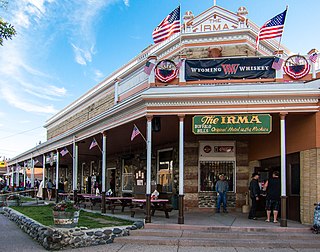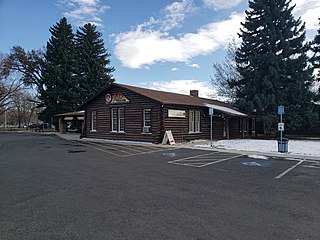
The Irma Hotel is a landmark in Cody, Wyoming. It was built by William F. "Buffalo Bill" Cody, the city's co-founder and namesake who named it after his daughter Irma Cody. A focal point is a famous back bar made of cherry that was a gift given by Queen Victoria to Buffalo Bill.

Wapiti Ranger Station is the oldest United States Forest Service ranger station in the United States. The station is in Shoshone National Forest west of Cody, Wyoming, and has been used continuously since it was built in 1903. On May 23, 1963, Wapiti Ranger Station was designated as a National Historic Landmark, and placed on the National Register of Historic Places on October 15, 1966.

The Sheridan Inn is a historic hotel in Sheridan, Wyoming. Designed by the architect Thomas R. Kimball of Omaha, Nebraska in 1893, it was constructed by the Chicago, Burlington, and Quincy Railroad as part of its development program in Wyoming associated with extension of the railway. Equipped with the first bathtubs and electric lights in that part of Wyoming, the inn was considered the "finest hotel" between Chicago and San Francisco. It was declared a National Historic Landmark in 1964.

Pahaska Tepee is William "Buffalo Bill" Cody's old hunting lodge and hotel in the U.S. state of Wyoming. It is located 50 miles (80 km) west of the town of Cody and two miles from the east entrance to Yellowstone National Park.

The Sheridan Flouring Mills, also known as the Mill Inn, are an industrial complex in Sheridan, Wyoming. The mills were a major component of the economy of north central Wyoming, providing collection, storage and milling of locally produced wheat and other grains into flour and other milled products. The original mill was established by Captain Scott W. Snively in the early 1890s. The Sheridan Milling and Manufacturing Company was sold to J.W. Denio in 1903, who operated the mill at its location on Broadway Avenue near downtown Sheridan. A catastrophic fire destroyed this mill in 1919, resulting in the purchase of a new location on Coffeen Avenue and construction of a much larger mill.

This is a list of the National Register of Historic Places listings in Sheridan County, Wyoming. It is intended to be a complete list of the properties and districts on the National Register of Historic Places in Sheridan County, Wyoming, United States. The locations of National Register properties and districts for which the latitude and longitude coordinates are included below, may be seen in a map.

The Downtown Albany Historic District is a 19-block, 66.6-acre (27.0 ha) area of Albany, New York, United States, centered on the junction of State and North and South Pearl streets. It is the oldest settled area of the city, originally planned and settled in the 17th century, and the nucleus of its later development and expansion. In 1980 it was designated a historic district by the city and then listed on the National Register of Historic Places.

The Buffalo Bill Boyhood Home was built by Isaac Cody, the father of Buffalo Bill Cody in 1841 at LeClaire, Iowa. The house was purchased as a tourist attraction by the Chicago, Burlington and Quincy Railroad and was moved to Cody, Wyoming, Buffalo Bill's adopted hometown, in 1933.

Buffalo Bill - The Scout is a bronze statue of a mounted rider outside the Buffalo Bill Historical Center in Cody, Wyoming, that was placed in 1924 to commemorate the town's most famous resident and de facto founder, Buffalo Bill Cody. Originally in open land on the western outskirts of Cody, the statue now stands at the end of Sheridan Avenue, which became the town's main thoroughfare as Cody grew to the west. The project was initiated by Buffalo Bill Cody's niece, Mary Jester Allen, who had established the basis of what would become the Buffalo Bill Historical Center. A New Yorker, she persuaded heiress and artist Gertrude Vanderbilt Whitney to sculpt the piece.

The Stock Center in Cody, Wyoming, United States, was built in 1927 as the original home of the Buffalo Bill Museum, serving in that purpose until the museum was relocated to a new complex across the street in 1969. The log structure is intended to suggest a stockman's log cabin, rendered on a large scale.

The Masonic Temple in downtown Casper, Wyoming is a Masonic hall, built in 1914 during a boom time initiated by the development of the Salt Creek Oil Field. Located on a corner site, the temple remains essentially as it was designed by Casper architect Homer F. Shaffer. The four story light-colored brick building rests on a raised basement and is topped by a crenelated parapet. The original windows have been replaced with vinyl units but retain the one-over-one appearance of the originals. Windows extend over the west and south sides. The north side is blank, while the east side is the building's rear facade and has fire escapes and a few windows.

The Downtown Thermopolis Historic District comprises the central business district of Thermopolis, Wyoming. The district comprises the main street, Broadway, and Fifth Street. The buildings lining the street were built between 1898 and 1923 in styles ranging from adaptations of commercial style to Victorian. The town was planned as a unit in 1896 after the land was acquired from the Shoshone and Arapaho. Broadway, as implied by its name, was built wide enough to accommodate teams of 16 mules or horses.

The Downtown Evanston Historic District in Evanston, Wyoming includes about sixty buildings in a compact downtown commercial district.

The Downtown Rock Springs Historic District is a 15.97-acre (6.46 ha) historic district that was listed on the National Register of Historic Places in 1994. It is roughly bounded by K, 4th, C, 2nd, A, and 5th Streets in downtown Rock Springs, Wyoming.
Frederic Hutchinson "Bunk" Porter, Sr., sometimes referred to as Frederick Hutchinson Porter, was an American architect based in Cheyenne, Wyoming. He was active from 1911 to approximately 1965. He designed many of Cheyenne's most important public and commercial buildings and also designed several buildings at the University of Wyoming, including War Memorial Stadium and the Agriculture Building. A number of his works are listed on the U.S. National Register of Historic Places.
Leon C. Goodrich was an American architect of Casper, Wyoming. A number of his works are listed on the National Register of Historic Places.

Warsaw Downtown Historic District is a national historic district located at Warsaw in Wyoming County, New York. The district encompasses 36 contributing buildings in the village of Warsaw. They are a variety of commercial, institutional, and religious buildings with most built between the 1870s and 1915. A number of commercial buildings were constructed after the fires of 1867 and 1887. They include the Andrew Jackson Warner designed United Church of Warsaw (1860s), First Baptist Church (1889), Bartlett Block, Hostetter's Pharmacy, New Watkin's Hotel Sullivan Building (1915), Wyoming County Bank, Glover's Department Store, Gardner's Grocery, Pratt Grocery, Farman-Humphrey Block (1884), Lincoln Block, and Schwab's Motor Sales. Located in the district and separately listed are the Warsaw Academy and United States Post Office.

The Brattleboro Downtown Historic District encompasses most of the central business district of the town of Brattleboro, Vermont. Extending along Main Street between Whetstone Brook and a junction with Pultney Road and Linden and Walnut Streets, this area includes many of the town's prominent civic and institutional buildings. The area's development took place primarily in the 19th century, with surviving buildings from both the 18th and early 20th centuries. The district was listed on the National Register of Historic Places in 1983, and was enlarged in 2004 to include Plaza Park and the Holstein Building on the south side of Whetstone Brook.

The Downtown Rawlins Historic District comprises the historic center of Rawlins, Wyoming. It comprises the area between Second and Sixth Streets and Front to Buffalo Streets and along 5th Street between West Spruce and West Cedar. The town owes much of its living to the Union Pacific Railway, which took advantage of spring in the Rawlins area to establish services there.

The Lander Downtown Historic District comprises the commercial core of Lander, Wyoming. The district includes 16 buildings listed as contributing to the historic district, including a series of commercial buildings, the Noble Hotel, the grand Theatre and the Stockgrower's Bar. The Federal Building is included, and is individually listed on the National Register of Historic Places as well. Most date between 1890 and 1910. Most earlier buildings burned or were torn down and replaced by more permanent masonry structures. By 1910 an oil boom had begun in central Wyoming, providing an incentive to build substantial buildings. The district comprises most of the north side of Main Street between Second Street and Fourth Street, with three properties on the south side and one facing Lincoln Street at Third Street.




















